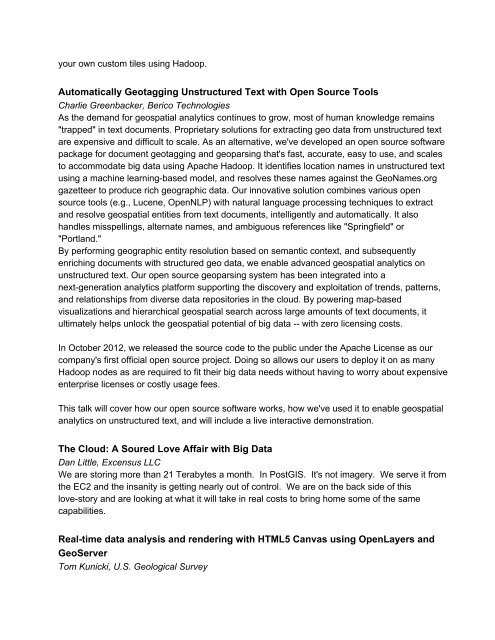FOSS4G North America Conference 2013 Preliminary Program
FOSS4G North America Conference 2013 Preliminary Program
FOSS4G North America Conference 2013 Preliminary Program
Create successful ePaper yourself
Turn your PDF publications into a flip-book with our unique Google optimized e-Paper software.
your own custom tiles using Hadoop.<br />
Automatically Geotagging Unstructured Text with Open Source Tools<br />
Charlie Greenbacker, Berico Technologies<br />
As the demand for geospatial analytics continues to grow, most of human knowledge remains<br />
"trapped" in text documents. Proprietary solutions for extracting geo data from unstructured text<br />
are expensive and difficult to scale. As an alternative, we've developed an open source software<br />
package for document geotagging and geoparsing that's fast, accurate, easy to use, and scales<br />
to accommodate big data using Apache Hadoop. It identifies location names in unstructured text<br />
using a machine learningbased model, and resolves these names against the GeoNames.org<br />
gazetteer to produce rich geographic data. Our innovative solution combines various open<br />
source tools (e.g., Lucene, OpenNLP) with natural language processing techniques to extract<br />
and resolve geospatial entities from text documents, intelligently and automatically. It also<br />
handles misspellings, alternate names, and ambiguous references like "Springfield" or<br />
"Portland."<br />
By performing geographic entity resolution based on semantic context, and subsequently<br />
enriching documents with structured geo data, we enable advanced geospatial analytics on<br />
unstructured text. Our open source geoparsing system has been integrated into a<br />
nextgeneration analytics platform supporting the discovery and exploitation of trends, patterns,<br />
and relationships from diverse data repositories in the cloud. By powering mapbased<br />
visualizations and hierarchical geospatial search across large amounts of text documents, it<br />
ultimately helps unlock the geospatial potential of big data with zero licensing costs.<br />
In October 2012, we released the source code to the public under the Apache License as our<br />
company's first official open source project. Doing so allows our users to deploy it on as many<br />
Hadoop nodes as are required to fit their big data needs without having to worry about expensive<br />
enterprise licenses or costly usage fees.<br />
This talk will cover how our open source software works, how we've used it to enable geospatial<br />
analytics on unstructured text, and will include a live interactive demonstration.<br />
The Cloud: A Soured Love Affair with Big Data<br />
Dan Little, Excensus LLC<br />
We are storing more than 21 Terabytes a month. In PostGIS. It's not imagery. We serve it from<br />
the EC2 and the insanity is getting nearly out of control. We are on the back side of this<br />
lovestory and are looking at what it will take in real costs to bring home some of the same<br />
capabilities.<br />
Realtime data analysis and rendering with HTML5 Canvas using OpenLayers and<br />
GeoServer<br />
Tom Kunicki, U.S. Geological Survey


